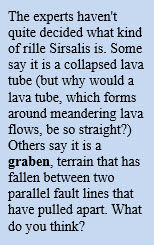 The week of November 19- 25 takes us from the end of Day 11 through Day 17. This week we will highlight the Sirsalis rilles, viewable on Tuesday evening.
The week of November 19- 25 takes us from the end of Day 11 through Day 17. This week we will highlight the Sirsalis rilles, viewable on Tuesday evening.
 Rimae Sirsalis: [SW/L3-4] Just in from the southwest shore of Oceanus Procellarum you will see two small overlapping craters, Sirsalis and Sirsalis A (by now you should be able to tell immediately which crater is older). Neighboring these two craters to the east and south is a complex of rilles. Rima Sirsalis is the most conspicuous, but it has lots of neighboring offshoots. How many can you see?
Rimae Sirsalis: [SW/L3-4] Just in from the southwest shore of Oceanus Procellarum you will see two small overlapping craters, Sirsalis and Sirsalis A (by now you should be able to tell immediately which crater is older). Neighboring these two craters to the east and south is a complex of rilles. Rima Sirsalis is the most conspicuous, but it has lots of neighboring offshoots. How many can you see?
With your telescope at its highest usable power, trace Rima Sirsalis through its full length. Along the way, try to discern the many smaller rilles that branch off. These require larger apertures and good seeing, but it’s worth the effort.
 Rima Sirsalis is a gift to amateur astronomers because it can be easily seen in the smallest of telescopes. At 240 miles long and two miles wide, it is one of the longest rilles on the Moon, and it reveals itself just before full moon–a time when most astronomers are putting their telescopes away!
Rima Sirsalis is a gift to amateur astronomers because it can be easily seen in the smallest of telescopes. At 240 miles long and two miles wide, it is one of the longest rilles on the Moon, and it reveals itself just before full moon–a time when most astronomers are putting their telescopes away!
Rima Sirsalis is unusual not only because of its great length, but because it cuts straight through a highland region and is rarely persuaded to deviate from its course. On its southern end, the rille begins just east of the crater Darwin, then proceeds north where it “empties” into Oceanus Procellarum. Spend a lot of time here. Draw the network of rilles and keep coming back to improve on what you saw.
======================
It is highly recommended that you get a copy of Sky and Telescope’s Field Map of the Moon, the very finest Moon map available for use at the telescope. It is available for $10.95 at www.skyandtelescope.com and on Amazon. All features mentioned in this blog will be keyed to the grid on the Field Map and will look like this: Plato: [NW/D9]
Credits:
Courtesy of Gray Photography of Corpus Christi, Texas
Lunar photos: NASA / USGS / BMDO / LROC / ASU / DLR / LOLA / Moon Globe. Used by permission
- Rupes Cauchy: A Best Known Fault on the Moon - July 22, 2024
- Moon Crater Schickard – Crater Floor has Stripes - July 15, 2024
- Moon Craters Langrenus and Vandelinus - July 8, 2024